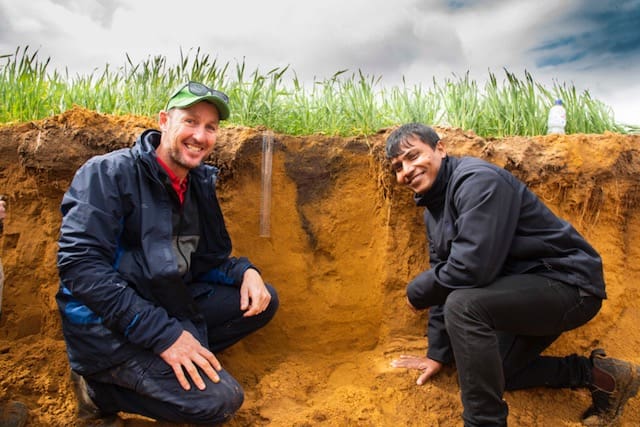
Kalannie farmer Bob Nixon (left) and DPIRD soil scientist Dr Gaus Azam inspect a field trial as part of a project to examine the interaction between lime, gypsum and cultivation on subsoil acidity and grain yields.
WHEAT yields from crops sown on acidic sandplain soil can be boosted by incorporating a combination of lime and gypsum with cultivation, according to initial results from a field trial at Kalannie in Western Australia.
Research by the WA Department of Primary Industries and Regional Development, supported by the Grains Research and Development Corporation, found the interaction between lime, gypsum and cultivation improved subsoil acidity and grain yields.
Department soil scientist Gaus Azam told the Liebe Group spring field day while lime had long been used to combat acidic soils, there was little known about the effect on acidity from combining some gypsum with lime in association with cultivation.
Dr Azam said benefits of incorporating lime and gypsum were amplified when applied together in the trial, especially when the soil was cultivated at depth.
“Our research suggests that incorporating lime using a one-way pass from a plough or rotary spader can increase soil pH well above the recommended level of 4.8 up to 20 centimetres deep, which eliminates aluminium toxicity,” Dr Azam said.
“The incorporation of lime and gypsum generated higher yields in soils with no compaction constraints compared with the deep ripped control of 0.8 t/ha wheat grain yield.
“The plots with lime produced a 14 per cent yield improvement, gypsum four per cent, while lime and gypsum used in combination resulted in a 26 per cent improvement – despite the dry start to the 2017 season.”
With 2018 looking like an above average season, department researchers are expecting an even better yield response due to further improvement of soil pH and reduced aluminium concentrations and greater soil water availability.
The trial evaluated four rates of lime applications of 0, 2, 4 and 6 tonnes per hectare and four rates of gypsum at rates of 0, 1, 2 and 3t/ha, using no cultivation and one way ploughing to a depth of 20cm.
The whole site was ripped to a depth of 450 millimetres to remove the effect of soil compaction.
The trial has been replicated this season and results will be disseminated in 2019.
Source: DPIRD

HAVE YOUR SAY